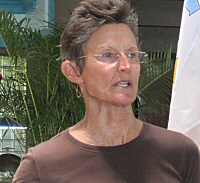
“But the reference colonies didn’t do too well either,” Garrison said, speaking to about 15 members of the Rotary Club of St. John at its weekly meeting at the Westin Resort and Villas.
Garrison, who works for the U.S. Geological Survey in Florida, began the study in 1999 while she was based on St. John. She and a cadre of volunteers affixed elkhorn, staghorn and finger coral fragments to dead coral using nylon cable ties. Garrison said she picked these species because they are the fastest growing.
She monitored the project during the ensuing years.
Garrison and the volunteers transplanted 30 pieces of elkhorn and 15 pieces each of staghorn and finger coral. One piece of elkhorn survived and thrived, and Garrison showed photos of how it’s grown.
“It’s a big multi-layer coral that’s home to fish,” she said.
Additionally, one piece of finger coral is still alive, Garrison said.
As for the reference colonies, Garrison said she’s noticed their health varies over time. She said sometimes they look good and sometimes they don’t.
According to Garrison, 30 percent of the world’s coral has died. Garrison said they’ve fallen prey to storms, high water temperatures, diseases, and being hit by boats.
Sunscreen worn by beachgoers is also an issue for corals because its chemicals interfere with coral reproduction, she said.
“Wear a rash guard instead of sunscreen,” she suggested, referring to an article of clothing worn by snorkelers and divers.
And she said acidification of the ocean caused by global warming lowers the pH of the water, which hinders the production of the calcium corals use to build their homes.
While the corals used to recover within five to 10 years, that’s not the case anymore, Garrison said.
“Now we’re seeing very little recover, particularly in the Caribbean,” she said.
Because coral isn’t recovering, there is more interest in restoring coral colonies, but Garrison said cost and success rates are factors. However, she said that, in her opinion, the effort is worth it.
“We can make a difference on a local and regional scale,” she said.
Garrison suggested that if people want to get involved in transplanting coral, they propose such project to V.I. National Park if they want to work in park waters or to the Planning and Natural Resources Department to work in local government-controlled waters. She said people can’t undertake such projects without the appropriate permits.





